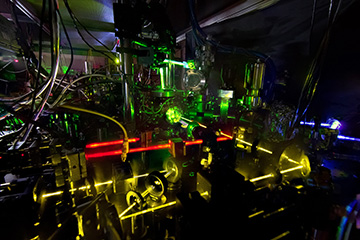
Researchers have measured this ytterbium optical clock’s ticking with record-breaking accuracy. The image is a stacked composite of about 10 photos in which an index card was positioned in front of the lasers to reveal the laser beam paths. [Image: Nate Phillips, NIST]
Any redefinition of a fundamental unit of measurement must be based on the most accurate standard possible. After eight months of experimental runs on a ytterbium lattice optical clock, scientists at a U.S. laboratory have made the most accurate measurement ever reported of the oscillations within the clock (Optica, doi: 10.1364/OPTICA.6.000448).
The accuracy test at the U.S. National Institute of Standards and Technology (NIST) meets the standard set by an international group of national metrology laboratories for an uncertainty measurement that compares with the current International System of Units (SI) definition of the second. Such accuracy could eventually lead to a redefinition of the second based on optical clocks, rather than the current baseline of microwave cesium-133 clocks (see “Toward the Optical Second,” OPN, February 2019).
Creeping up on redefinition
For the 79 experimental runs, each lasting an average of 4.9 hours, the NIST scientists used the ytterbium optical lattice setup that they have been steadily improving for several years. A frequency-doubled pulse from an 1156-nm quantum dot laser excites the 578-nm transition between two levels of neutral ytterbium-171 atoms trapped in an optical lattice. Some of the light is diverted to a self-referenced Ti:sapphire frequency comb, then downconverted and compared to hydrogen masers. The scientists also referenced the signal against other nations' frequency standards.
The NIST group measured the absolute frequency of the studied atomic transition to 17 significant figures, with an uncertainty below 3 x 10–16—the most accurate to date, and the first uncertainty measurement that meets one of the International Committee for Weights and Measures' requirements for redefining the second. Such a redefinition could improve the positional accuracy of global navigational satellite systems, plus other benefits.
Bonus analysis: Einstein's still OK
As a bonus, the NIST team reanalyzed its experimental data to examine the coupling of electron–proton mass ratio to the effects of a gravitational potential, as seen in some theoretical physics models. The scientists tightened the constraint on this effect to “almost fourfold” that of previous measurements and found that the annual change in the mass ratio due to the Sun's gravitational potential is only about 5.3 x 10–17. Plus, they found no violation of Albert Einstein's equivalence principle.
